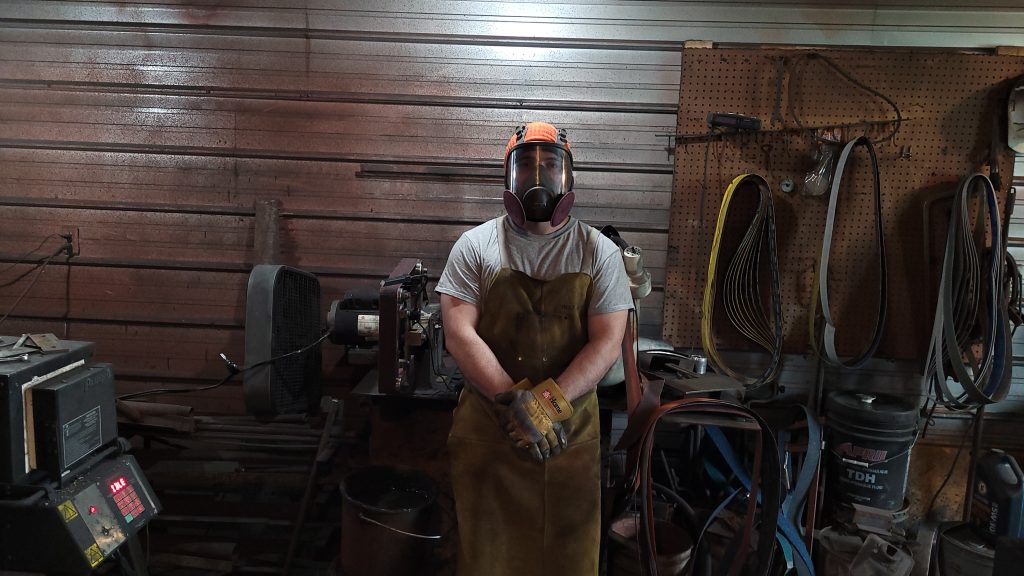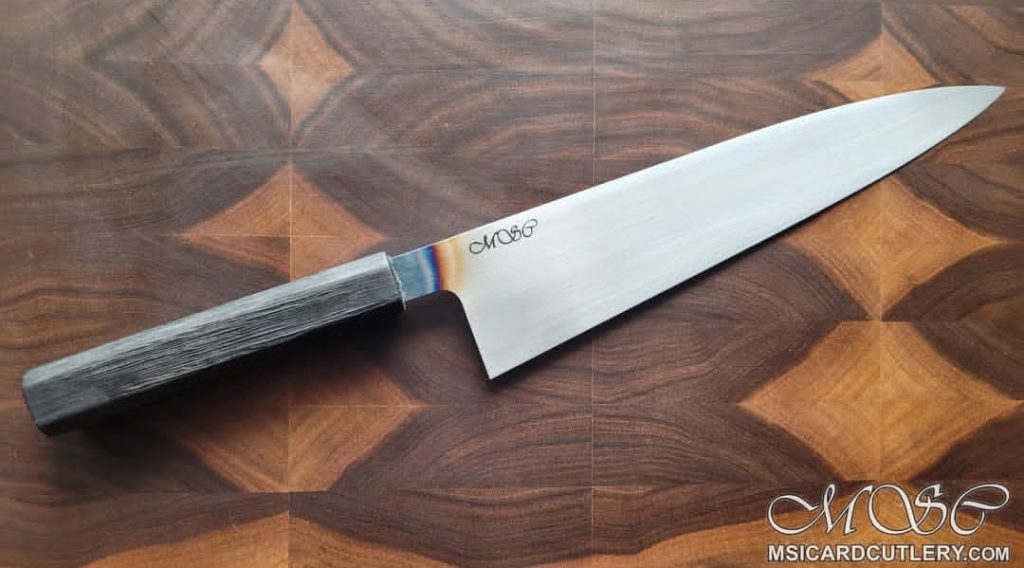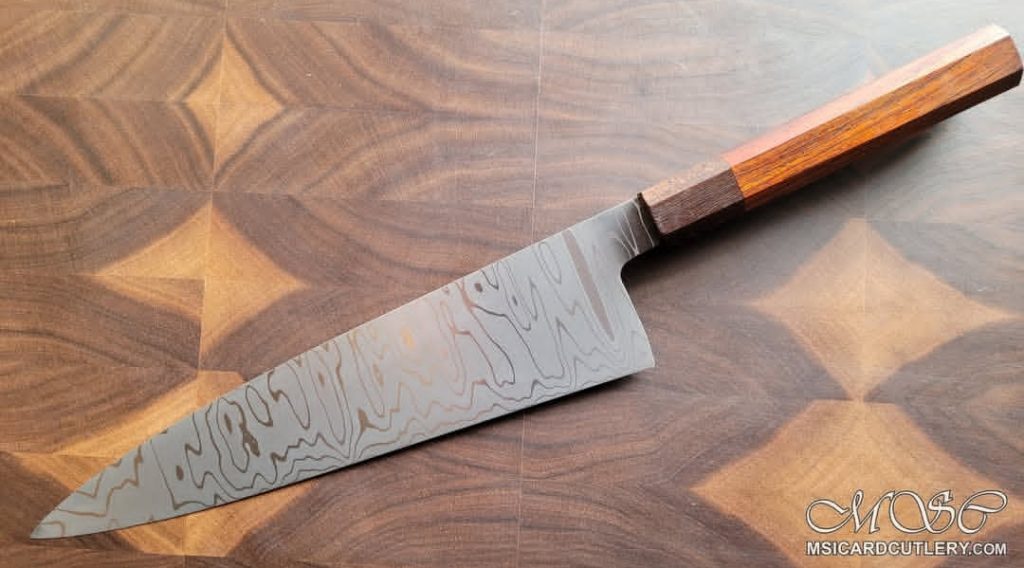
Before I ever saw one of his knives, I was interested in his work. I saw his name popping up in some knife communities and I wanted to know more. I am so glad that I did. He has a real gift for getting to the essence of what makes a knife great. The result? Very dialed in performance.
To start off, please tell us a little about yourself.
My name is Matt Sicard, I’m a 26-year-old full time bladesmith of 3 years. Before I made knives full time I worked underground in the mining industry.
What sparked your interest in knives
If I had to guess, I’d say it was probably swords. My father was a martial arts instructor before he was married so there were a couple of swords in the house when I was a kid and I grew up watching movies and TV shows where they were a central element (“The Three Musketeers”, “The Princess Bride”, “Samurai Jack”, “Avatar”, “Star Wars”, and later “Highlander”). I also recall seeing a History Channel documentary on katana making that was available on YouTube in the early days of the platform that probably first sparked my interest in bladesmithing.
What inspired you to do this and how did you learn?
I developed my interest in the craft by seeing other people practice it on YouTube ages ago. I learned by watching, reading and a lot of trial and error. I’ve never had a formal teacher or a mentor, I’ve just sort of picked things up through observation and practice. Granted I have had some pretty extensive discussions on metallurgy with other bladesmiths.
When did you start making knives?
I think I was 8 or 9 when I tried knifemaking for the first time.
What did you make your first knife with?
The blade was tanto style and was made from a piece of rebar I forged out. I worked on it on and off for about 2 years (I think) and did almost all of it by hand. I used a short 4lb sledge, the shop stove, an anvil, a bench grinder, files, and 80% of a coarse SiC sharpening stone.
Do you have a favorite knife you made, tell me about it?
Moment to moment when I’m making knives I tend not to compare them against others I’ve made, but as time goes on I realize that sometimes I’ve made something that stands above other blades like it. Sometimes it’s the forging, or the food release, the way the blade feels on a board, the symmetry or even just the overall aesthetics. Part of what makes handmade knives cool is that variability IMO (though it’s a two way street). I think it’s cool that even within the catalogue of a single maker, floating around are these unique “gems” that stand out above others.
What is the most important aspect of a well-made knife?
This is a hard one. Everyone has their own take but as far as physical features go it has to be the geometry. Even badly heat-treated steels will cut well with good geometry, just perhaps not for very long. And the reverse is also true. Well heat treated steel with bad geometry will not make for a very good knife. No amount of branding or aesthetic embellishment will compensate for the inutility of a poorly ground blade (though the added cost may stop people from complaining too loudly).

What keeps you going?
What keeps me going is largely a two-part mix of necessity and personal freedom. Being self-employed is hard, especially starting out, but having the flexibility that comes with making my own schedule is more wonderful than I would have ever anticipated.
Biggest struggle?
Even my friends would know this if you asked them (…not that I ever complain). Marketing. I can’t stand it. If I ever grow enough to have employees it will be the very first task I delegate.
What kinds of knives do you make?
Generally speaking, I stick to making kitchen knives, though I do occasionally make outdoors knives. This year I’ve decided to expand into sword making, which really is what drove my interest in the first place.
How did your background affect your approach to knives?
I think it made me more pragmatic and utilitarian in my approach. I’ve tended to be very apprehensive about doing/using some things that I would categorize as having diminishing returns on performance. Especially new or boutique materials, especially with customers who are new to custom knives and not experienced collectors. Some people would consider it a bad business practice, but I spend a decent bit of time trying to talk people out of chasing hyped steels/grinds/handle materials when I can often provide them with 80-90% of the performance for 1/2-2/3 the cost.
Who helped you early on?
For the most part online forums did. I never really had any 1 on 1 discussions or direct instruction. At this point most questions have been asked, so finding answers is easy for most things. After that it’s just a matter of putting the information into practice.
Who are your influences?
Oh, jeez this is a list. Devin Thomas, Kevin Kashen, Karl Anderson, Will Stelter, Green Beetle, Stacey Apelt, Emiliano Carrillo, Niko Hynninen, Daniel Cauble, Peter Burt, Alec Steel, Walter Sorrels, Murray Carter, Naohito Myojin, Ben Kamon, Milan Gravier, Master Honami, Gassan Sadatoshi, Damian Kordic, Pavel Bolf, Shurap, Brett Onik, Kyle Royer, David DelaGardelle and more. And I can recall precisely how and why each of them did.
What other knife makers out there impress you these days? Do you take inspiration from anyone else in the field?
There are many. Naohito Myojin’s grinds are something I draw heavily on. Salem Straub, Charles Lionheart and Nick Anger’s mosaic damascus are incredible. Niko Hynninen’s wootz is some of the best in the world. Devin Thomas’ enormous breadth of stainless damascus patterns and san-mai combos is awe-inspiring. All of these people I consider to be absolutely top tier, and they set the bars that I strive to reach.
Any specific breakthroughs or revelations in your knife making journey?
Oh, so, so many. Forge welding well and reliably, especially stainless damascus was a huge one. The importance of convexity and taper and how they influence kitchen knife performance. Just basic order of operations stuff. Wootz is what I’m trying to wrestle with now. It’s maddening but addictive. There have been too many “aha” moments to count.
What is the perfect knife?
I think the perfect knife is a myth. “Perfect” and “best” are great attention-grabbing headline words but when it comes to knives I really don’t think they’re meaningful descriptors. Two weeks ago someone told me the knife I made him was the best he’d ever used and absolutely annihilated another knife he owns which was made by a very, very, popular mastersmith. A knife, I’ll add, that he paid about 5x more for. Last week I received an email from someone telling me the knife I made them was the worst they’d ever had out of the box (he’s since modified it to make it better suited to him)—–and these knives were not all that dissimilar. I doubt that experience is unique to me. Everyone brings with them a different set of expectations that influences how they evaluate their blades. There is no one size fits all magic bullet style answer. Generally speaking I think that any knife that pleases its owner and that the maker is satisfied with is more than adequate. The ideal knife to me isn’t just one that functions as a knife but does so in a way that brings joy to the person using it.

How do you approach knife testing?
I did a lot more testing when I was first starting out. These days I usually only perform extensive testing on blades when I change something about my process, but I almost always do some test cuts before shipping a blade, usually on potatoes. They’re dense and quite sticky so they make for a good test medium. I’ll usually make draw cuts, push cuts, do some chopping, and horizontal cuts to test for ease of cutting and food release.
How do you develop a design, select a steel, and fine-tune a heat treatment?
At this point I’ve largely settled on variations of Sabatier and Masamoto KS patterns. Sometimes I make an oddball shape just to get a feel for it (generally changing only one dimension), but for the most part I consider myself to be underqualified to be making wildly new profiles for kitchen knives, so I just build on tried and tested ones. Taller heels, lower tips, larger flats, different stock thicknesses etc. When it comes to steels, I tend to be quite pragmatic in my choices, and I inform those choices with the best data we presently have which is that of Larrin Thomas. 52100 and AEB-L have the best hardness/toughness balances of their respective classes (carbon and ingot SS) so I tend not to deviate that often from them. There’s just no need. Sometimes I do buy steels just for the novelty of working with new steels, but I tend to stick to a few old standbys. 52100 for carbon, AEB-L for SS, and 26c3 and W2 tool steel for honyaki. When it comes to PM steels I really like Zwear, M4 and MagnaCut. They’re all very high wearing steels that sharpen wonderfully and have good toughness and high attainable hardness. When it comes to selecting a heat treat it depends somewhat on the steel. As a general rule I try to achieve the maximum hardness the steel is capable of from the lowest temperature possible. There are some exceptions, like Apex Ultra, in that particular case maximum hardness would be only about 1.5-2 hrc higher than I currently aim for, and it would cut the toughness to an unacceptable degree in my opinion…plus as I heat treat it now the hardness is already in excess of 66 hrc, so there isn’t much need to push it further.
How has the knife world changed since you started?
If you count from the time, I made my first knife around age 9, it has totally revolutionized. Most of that change has come in the last 6 years or so. When knifesteelnerds.com hit the web and started gaining some traction everything really changed and while there has been some latency in terms of how that information has been disseminating its way through the world, the difference is huge. Greater than night and day. Larrin has put so so so many longstanding myths to bed about heat treatment and performance and how different variables affect performance. I can’t overstate the value of his work. There were many pointless procedures and metallurgical fallacies accepted as the absolute truth and they’ve been largely disproven. In addition to that, many areas of speculation were tested and the results quantified (cold forging, damascus cutting effect, cryo for carbon steels, low range tempering for tool steels). On top of that the interest in the craft and field has really grown in the last decade. I think in part with the help of Forged In Fire. The format of the competition seems a little inconsistent to me, and I haven’t watched it extensively, but it really gave bladesmiths a big platform to showcase their work and it’s done wonders for growing and establishing respect for our craft.
What’s up next for you? Any exciting new projects to tell us about?
Next for me is really more of the same. You can be infinitely picky about almost anything so really I’ll just be trying to refine processes I already use. Making watered wootz, more interesting hamons, stainless damascus, swords, outdoors knives and so on.
For more information on Matt’s work visit his website at www.msicardcutlery.com or his Instagram at http://www.instagram.com/msicardcutlery
Leave a Reply